CIRCLE TIME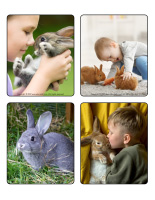
Animated discussion-Rabbits
(Open picture game-Rabbits) Print and laminate the illustrations in the format you prefer. Use them to spark a conversation with the children in your group.
Poni discovers and presents-Rabbits
(Open Poni discovers and presents-Rabbits) Print the various cards. Laminate them and cut them out. Use your Poni puppet (or another puppet children are familiar with) to present the different types of rabbits to your group.
To welcome children in the morning, wear bunny ears on your head.
Hang stuffed rabbits from your daycare ceiling or hide them among toys. Children will ask you questions when they find them. Use them to introduce your theme.
Bunny tracks
(Open bunny tracks) Print and cut out. Deposit the tracks on the floor. Sprinkle baby powder around the contour of each track. Remove the paper paws to reveal bunny tracks. Make several tracks and let children discover them when they arrive in the morning. What an interesting way to introduce your theme!
Visit a pet store with your group so they can see live rabbits.
Discussion period
Ask children the following questions to get them talking: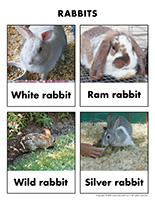
- Have you ever held a rabbit?
- Have you ever seen a rabbit?
- Do you know another animal that looks a lot like a rabbit?
- What color are rabbits?
- Do rabbits have small or big ears?
- How do rabbits move?
- Do rabbits have fur or feathers?
- Can a rabbit lay an egg?
AREA SETUP
Thematic poster-Rabbits
(Open thematic poster-Rabbits) Print, laminate, and display where children and parents are sure to see it.
Educa-decorate-Rabbits
(Open educa-decorate-Rabbits) Print, laminate, and cut out the illustrations. Use them to decorate your walls and set the mood for the theme.
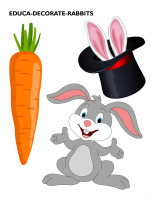
Stickers-Rabbits
(Open stickers-Rabbits) Print the illustrations on adhesive paper and use them to create a collection of unique stickers. Use them to reward children throughout the theme.
Educa-theme-Rabbits
(Open educa-theme-Rabbits) Print and laminate the different elements representing the theme. Use them to present the theme to your group (and children’s parents) while decorating your daycare.
Transform your daycare to represent a forest. Draw trees on paper banners or brown paper bags that you have cut open. To decorate the trees, use a hole-punch to make a hole in several dead leaves and thread a ribbon or string through each one. Hang them in front of your mural. Glue leaves at the base of your tree trunk. Have each child trace the contour of his hands on colorful construction paper and cut them out. Children’s cut out hands can be used to represent leaves. Add pinecones, apples, etc.
Door decorations-Rabbits
(Open door decorations-Rabbits) Print, laminate, and cut out the items. Use them to decorate your daycare door and set the mood for the theme.
Group identification-Rabbits
This tool was created in response to a special request we received. (Open group identification-Rabbits) Print and use the items to decorate your daycare and identify children’s belongings and personal areas.
Garland-Rabbits
(Open garland-Rabbits) Print the items and let children decorate them. Hang them within your daycare to form a garland.
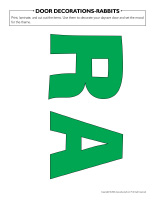
Rabbits everywhere
Collect several cardboard boxes and wrap them with white paper. They will become rabbit heads. For each box, cut 2 large rabbit ears out of white cardboard. With the children in your group, color the center of each rabbit ear using a pink crayon. Set the boxes vertically on the floor throughout your daycare. Glue 2 ears behind each one. Next, cut 2 circles out of black Fun Foam for each box. Glue them where the rabbits’ eyes should be. Children can use white chalk to draw a pupil in the center of each eye. Provide a variety of materials and let children add a nose, whiskers, and rabbit teeth to each box to create unique rabbits. Have fun naming your rabbits. Another idea: if you cut an opening where the rabbit mouths should be, you can use the rabbits to store material linked to the theme (books, figurines, stuffed animals, coloring pages, stickers, etc.).
PICTURE GAME
(Open picture game-Rabbits) Use the pictures to decorate your daycare or to spark a conversation with your group. Print, laminate, and store the pictures in a Ziploc bag or in your thematic bin.
Memory game-Rabbits
(Open picture game-Rabbits) Print the illustrations twice and use them for a memory game.
ACTIVITY SHEETS
(Open activity sheets-Rabbits) Print and follow instructions.
WRITING ACTIVITIES
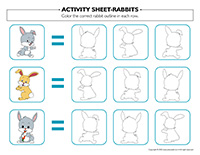
Writing activity-R like rabbit
(Open writing activities-R like rabbit) Print for each child or laminate for use with a dry-erase marker.
Educa-nuudles-Rabbits
(Open educa-nuudles-Rabbits) Print for each child. Have children color the sheet. Once they are done, they may use Magic Nuudles to turn the coloring pages into three-dimensional works of art.
Variation: If you do not have Magic Nuudles, ask children to fill the spaces designed for Magic Nuudles with bingo markers or stickers.
To order Magic Nuudles:
http://www.educatout.com/catalog/index.php?cPath=76&osCsid=dd5f6e4b9a9a91cbd4f9a233494afbff
Stationery-Rabbits
(Open stationery-Rabbits) Print. The stationery can be used to communicate with parents, in your writing area, or to identify your thematic bins.
VARIOUS WORKSHOPS-Rabbits
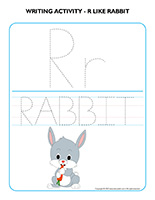
Construction/building blocks :
- Break out your miniature farm.
- Easter straw can be used to represent hay. Children can build on it, use it to feed rabbits, etc.
Arts & crafts:
- Coloring pages related to the theme.
- Cardboard bunnies for coloring, cutting, pasting, or for making puppets.
- Provide recycled material children can use to represent a miniature farm.
- Plastic rabbits that children can press in paint and use to make impressions on a paper banner.
- Farm animal stamps and stencils.
- A large piece of white paper (or a bed sheet) that children can use to create a rabbit-filled mural.
Role play:
- Farmer’s costume: straw hat, checkered shirt, rain boots…
- Decorate the area with rabbits, other farm animals, etc.
- Transform your area to create a puppet theater. You’ll be amazed by the scenarios children will come up with!
Manipulation:
- Memory game involving pictures of rabbits (store-bought version or make your own using Educatall illustrations).
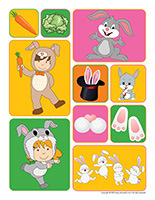
- Board games, lotto, or other games involving rabbits.
- White, black, and brown modeling dough that children can use to create rabbits. Ideally, use homemade dough so that children can mix colors. You may also choose to provide bunny-shaped cookie cutters.
- Puzzles with rabbit or farm animal scenes.
- Association games involving pictures of farm animals and farm animal sounds.
Reading and relaxation:
- Books about rabbits (visit your local library). You can even invite children to bring books they may have at home to daycare.
- Stuffed rabbits that children can cuddle with.
Music and motor skills:
- A song box containing titles of rabbit-themed songs and rhymes.
- A short story in which children must make various animal sounds.
- An imitation game where children must represent rabbits.
Sensory bins: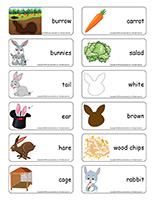
- A water table to explore with plastic rabbit figurines.
- Farm animals in a bin filled with Easter straw (or real hay).
- A bin filled with oats (several farm animals eat this type of cereal).
LANGUAGE ACTIVITIES
Word flashcards
Use the flashcards to spark a conversation with your group, in your reading and writing corner, or to identify your thematic bins. (Open word flashcards-Rabbits) (Open giant word flashcards-Rabbits) Print. burrow, bunnies, tail, ear, hare, cage, carrot, salad, white, brown, wood chips, rabbit
Let’s chat
Print and laminate the theme’s word flashcards. Have each child pick a word. They can take turns presenting their word to the group (ex. burrow). Discuss each item and ask children questions to see what they know about the theme.
Circle time game-Rabbits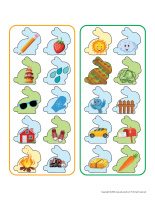
(Open circle time game-Rabbits) Print and laminate the cards. Give one to each child. Prepare a small bowl containing 10 cotton balls (rabbit tails). Children take turns inventing a rabbit story. The object of the game is for them to integrate as many elements illustrated on their card as possible in their story. The other children listen closely. When they recognize an element that it is illustrated on the storyteller’s card, they set a rabbit tail on it. This is a great way to practice listening skills.
Educa-chatterbox-Rabbits
(Open educa-chatterbox-Rabbits) Print and laminate the cards. To create your chatterbox, you will need an empty shoebox or a small bin that you can decorate as you see fit. Fill it with tiny objects, illustrations, pictures, and accessories related to your theme. To help you, we have created a series of cards that you may use. During circle time or, for example, when children are waiting for their lunch, have them take turns picking a card or object out of your chatterbox and naming the corresponding item.
Associating words and pictures
(Open word flashcards-Rabbits) (Open giant word flashcards-Rabbits) Print, laminate, and display the word flashcards on a wall, next to your circle time area or on a large piece of cardboard that can easily be moved around. Name a word and have children identify it.
ROUTINES ET TRANSITIONS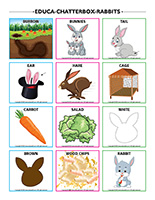
Game-This is my spot-Rabbits
(Open game-This is my spot-Rabbits) Print each illustration twice. Use adhesive paper to secure one copy of each illustration on the table. Deposit the second copy of each illustration in an opaque bag and invite children to pick a card that will determine their spot at the table (corresponding illustration). The illustrations can also be used to determine children’s naptime spots or their place in the task train.
My rabbit path
(Open my rabbit path) Print, laminate, and stick the illustrations on the floor to create a path leading to the areas children visit most throughout the day such as the bathroom, the cloakroom, etc. If you prefer, use the illustrations to define various workshop areas.
Theme presentation
Set baskets on the floor to greet children in the morning. Set stuffed rabbits in the baskets and add paper carrots. Simply type “carrot” in the Educatall Club’s search engine to find several interesting models that you may use. Let children manipulate everything freely. Encourage them to feed the rabbits.
Illustrated rabbits
Find several rabbit pictures and illustrations. Glue them on items throughout your daycare. Use walls, cupboards, and even the floor. Children will enjoy discovering them as they move about.
Carrots for the rabbits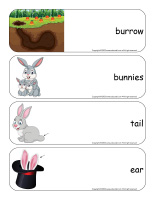
Create a few rabbits that will keep children occupied during waiting periods in the hallway. For each rabbit, you will need 2 white paper plates. Glue them one on top of the other. On each top plate, glue 2 wiggly eyes and draw a nose, a mouth, and whiskers. Glue a large white pompom on the side of each bottom plate to represent a bunny tail. Glue 2 empty paper towel rolls behind each top plate to represent bunny ears. Set the rabbits at the bottom of a wall in your hallway by pressing adhesive putty behind the cardboard tubes. Note that the plates (bunny bodies) must not be glued to the wall. Children will have fun dropping tiny orange pompoms in the bunny ears and seeing them fall on the floor. Encourage them to count the pompoms.
Ears are for listening
Purchase a bunny ear headband for each child (or make your own using simple headbands and construction paper ears). During circle time, story time, or any period when children must listen closely, invite them to wear their bunny ears so they can listen to what their peers or early childhood educator has to say. When you do not have access to the bunny ears, you can simply place your hands on your head to represent bunny ears and tell children, “Put your bunny ears on, I need you to listen very carefully.”
ACTIVITIES FOR BABIES
Soft like a rabbit
Collect several stuffed animals which represent different farm animals. Let children manipulate them. Make sure they notice how soft they are.
Rabbit mobile
(Open models-Rabbits) Print, cut out, and decorate the rabbits with glitter, lace, ribbon, cotton balls, confetti, etc. Glue the rabbits back-to-back on either side of a piece of ribbon or string. Hang from the ceiling.
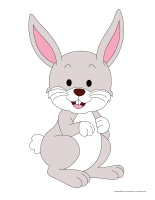
Soft rabbit
Give each child a sheet of paper with a printed rabbit shape on it. Have them fill the shape with cotton balls. Variation: Draw a rabbit shape on a piece of cardboard or adhesive paper. Have children fill the shape with cotton balls.
PHYSICAL ACTIVITY AND MOTOR SKILLS
Rabbit lacing
(Open lacing-Rabbits) Print, laminate, and punch holes around the contour of the shapes. Children can use a string, a shoelace, or ribbon to lace the shapes.
Rabbit tail game
(Open game-The rabbit's tail) Print and display the rabbit on the wall, at children's level. Glue a cotton ball on each tail. Children must try to glue their tail as close to the correct spot as possible while blindfolded. Variation: Draw a rabbit holding an empty Easter basket. With their eyes closed, children must try to stick an egg inside the rabbit's basket.
Colourful rabbits
Divide your group into two teams and have each team stand on a line at opposite ends of the daycare. Assign the same color to one rabbit from each team (two yellow rabbits, two blue rabbits, etc.). Deposit a carrot in the centre of the daycare. When you name a color (yellow rabbits for example), both children who were assigned this color must run and try to grab the carrot. The child who succeeds earns a point for his/her team.
Rabbit race
Stand in a circle. All children hold hands, except for one child who will be the rabbit. The rabbit stands outside of the circle, holding a basket. The rabbit hops around the circle and deposits the basket behind a child. As soon as the basket is deposited, the rabbit runs around the circle. The child who finds the basket behind him/her must run after the rabbit and try to touch him/her before the child reaches the spot where he was initially standing. The game continues.
Rabbit marathon
Deposit several carrots in a row on a table. At the other end of the daycare, children pull a pillowcase over their legs and hop to the table to collect a carrot. Once they have their carrot, they must hop back to the starting point.
Where are the rabbits?
(Open tiny bunny) Print and laminate. Hide tiny rabbit shapes throughout the daycare, placing them so that only the tips of the ears are showing. When you give them the signal, children search for the rabbits. There is no winner for this activity. The goal is simply to have fun. At the end of the activity, you may give each child one rabbit. They will be happy to bring their rabbit home at the end of the day.
Peter Rabbit game
(Open tiny bunny) Print and laminate. Sit in a circle with your group and show them Peter Rabbit. Have children close their eyes while you hide the rabbit. When you give them the signal, children search for Peter Rabbit. When a child finds the rabbit, reward him/her with an Easter sticker. Invite children to sit back down and have the child who found the rabbit hide it for the next round.
Modeling dough activity placemats-Rabbits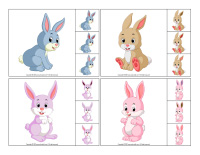
(Open modeling dough activity placemats-Rabbits) Print and laminate. Let children pick a placemat and provide modeling dough. Encourage them to use the dough to fill or reproduce the shapes that are on their placemat.
Educ-clothespins-Rabbits
(Open educ-clothespins-Rabbits) Print and laminate. Children must find and identify the matching illustration using a clothespin.
String activities-Rabbits
(Open string activities-Rabbits) Print for each child. Children trace the outlines with white glue before covering them with colorful string.
Roll and color-2 dice-Rabbits
(Open roll and color-2 dice-Rabbits) Print the dice and assemble them. This game is great for teaching counting skills while encouraging children to be active. Roll the first die to determine how many steps children must take. Roll the second die to determine which action they must perform. Next, have them color the corresponding rabbit. Repeat until all the rabbits are colored.
Rabbit hideouts
Provide several large boxes and let children hide in them just like rabbits hide in their burrow.
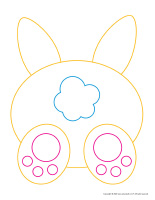
Follow the rabbit
Children hold hands. They must follow the rhythm of the first child in line. The first child in line can choose to tiptoe, stomp, take large or small steps, walk backwards, hop, etc.
Rabbit construction
Cut several circles out of pastel Fun Foam sheets. On each one, draw a bunny nose and whiskers using a permanent marker. For each circle, you will need 2 clothespins of the corresponding color. Draw an eye on the tip of each clothespin. Set all the material in a bin. Children must pick a bunny face, find the 2 matching ears, and attach them to the top of the bunny face to complete it.
Cutting bunny ears
For this activity, you will need plastic Easter eggs. Take a few sheets of white paper and cut 2 cm x 8 cm slits along both longer sides, creating fringes. Older children can help you with this step. Next, cut each piece of paper into 4 equal parts and wrap each piece around the top 2/3’s of a plastic Easter egg, with the fringe at the top. Secure it in place using adhesive tape. Draw a rabbit face on the uncut portion of paper. Let children cut the fringe to represent bunny ears and play with the rabbits.
Beware of the rabbit
Select a child who will be the rabbit. He chases his peers. When he touches another child, that child becomes the rabbit. Variation: Instead, have children who are touched by the rabbit stop in their tracks and stand with their arms out to the side until another child frees them by running under their arms.
Rabbit obstacle course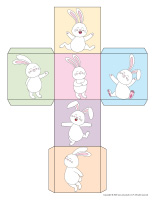
Pull your curtains and turn off the lights. Create an obstacle course throughout which children must collect glow sticks. Have them hop from one obstacle to the next. At the end, have the connect the glow sticks to create a circle of light.
Game-Where are the rabbits?
(Open game-Where are the rabbits) Print and laminate. Set tiny bunny pictures throughout your daycare, leaving only a small portion of each one visible. When you give the signal, children search for the rabbits. If you wish, have children search for rabbits of a specific color.
Giant rabbit
(Open pieces giant rabbit) Print, laminate, and cut out. Children assemble the pieces on the floor to create a giant rabbit.
Rabbit tag
All the children pretend to be rabbits except one, who will be the fox. To protect themselves from the fox, the rabbits must curl up in a ball and hug their knees when the fox touches them. The last rabbit becomes the fox for the next round.
Tiny bunny
Have children sit in a circle. One player is the rabbit. He stands outside the circle. The rabbit walks around the outside of the circle and sets a basket behind a seated child. As soon as this child realizes the basket is behind him, he jumps up and chases the rabbit around the circle in an attempt to touch him before he is able to sit in his empty spot. If he succeeds, the same child resumes the role of the bunny. If the bunny was able to sit down before being touched, the child who was seated becomes the bunny.
OUTDOOR ACTIVITIES
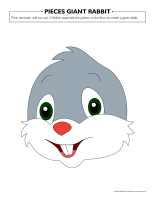
Rabbit burrows
In your yard, set 3 buckets upside down and deposit a hula hoop on each one to represent burrows. Attach a ribbon of a different color around each child’s right arm. Make sure children can name their color. Have them all stand on a line, at one end of the yard. Name one or several colors. The children wearing a ribbon of the corresponding color(s) run to a burrow. They must hop inside the burrow without making the hula hoop fall off the bucket. Let children take turns leading the game.
Rabbit and friends obstacle course
Set up an obstacle course in your yard (or daycare). Include a tunnel that children can crawl through like a rabbit digging a tunnel to his burrow, ropes on the ground that children can walk on like a squirrel walks on a fence, logs that children can carry like a beaver, and hula hoops they can run around, like a hamster on his wheel, tiny footsteps that they can walk on like a mouse, a kiddie pool filled with leaves or wood chips that they can roll around in like a guinea pig, etc.
Rabbit ears
(Open rabbit actions) (Open bunny ears) Print and cut out the ears and the action cards. Have each child wear a construction paper headband and attach the bunny ears to it. Children stand at one end of the yard. Stand at the opposite end of the yard, holding the action cards. When you show children the picture of the sleeping rabbit, they must lie down and pretend they are sleeping. When you show the picture of the hopping rabbit, children must hop once in your direction. Finally, when you show the picture of the eating rabbit, children pretend they are munching on a carrot.
Bunny hops
(Open bunny hops) Trace, cut out and secure the Easter shapes on the ground. Children must hop on the shapes to go from one activity to another.
Easter Bunny, may I?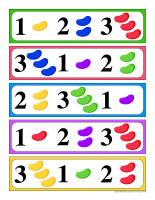
You are the Easter Bunny. Give children instructions (hop two times, wiggle your nose, etc.). Before executing your instructions, children must ask you, "Easter Bunny, may I?" You can respond, "Easter Bunny says yes." If you do not want them to execute your instruction, simply say, "Easter Bunny says no."
Easter Bunny says
The leader of the game gives children instructions using "Easter Bunny says..." instead of "Simon says...". Examples of actions: hop like a rabbit, munch on a carrot, wiggle your bunny tail, etc.
COGNITIVE ACTIVITIES
Hungry rabbit
(Open hungry rabbit) Print, laminate, and cut out the cards. Set a pink drinking glass upside down on the table. Cut a small opening near the bottom (rim of the glass) that will become the rabbit’s mouth. Cut 2 large rabbit teeth out of heavy paper and glue them at the top of this opening. Glue 2 wiggly eyes and a nose that you have cut out of felt over the mouth. Add whiskers (yarn or pipe cleaners). Empty the contents of a bag of jellybeans on the table, around your hungry rabbit. You are ready to play! Children take turns picking a card, looking at the illustrated candy and feeding the rabbit accordingly. They can push the candy inside the rabbit’s mouth using a Popsicle stick, a spoon, or a clothespin. Every time a child completes his turn, lift the glass so that his peers can check his work. Name the colors and count the jellybeans as a group.
Bunny tails
(Open bunny tails) Print, laminate, and cut out the squares containing rabbits with no tail. Prior to the activity, glue colorful pompoms on the tip of several wooden clothespins. The pompoms will represent rabbit tails. Each child picks a card, finds the tails of the corresponding colors and sets them in the right spots as they name the colors one by one.
Educa-dots-Rabbits
(Open educa-dots-Rabbits) Print for each child. Give each child a tiny bowl filled with poster paint and a cotton swab. They must dip their cotton swab in the paint and then on each dot to color the letters or items. Let dry and display. Use their work to name the letters or items with your group.
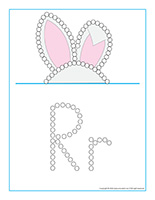
Game-Four rabbits
(Open game-Four rabbits) Print, glue the cards on opaque cardboard and cut them out. Arrange all the cards upside down on the floor or table (so you can’t see the illustrations). Children take turns rolling a die. Every time a child rolls a “1”, he can turn a card. If he doesn’t already have this rabbit in front of him, he keeps it and places it in front of him for everyone to see. The first child who has collected all four rabbits wins.
Counting cards-Rabbits
(Open counting cards-Rabbits) Print and laminate. Prepare a series of wooden clothespins on which you can paint or draw numbers 1 to 9. Children count the items on each card and place the corresponding clothespin on the correct number.
Color by number-Rabbits
(Open color by number-Rabbits) Print for each child. Have children color the picture per the color code.
Snakes and ladders-Rabbits
(Open snakes and ladders-Rabbits) Print and laminate. Use a die and tiny plastic rabbits as playing pieces.
Coloring hunt and seek-Rabbits
(Open coloring hunt and seek-Rabbits) Print and laminate. Children must find and color the items.
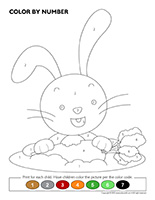
Homemade wooden puzzles
Print pictures of rabbits and color them if necessary. Press several Popsicle sticks together and glue a picture on top of them. Cut around each stick and set them in a Ziploc bag. Repeat with the other pictures. Children will enjoy placing the sticks in the correct order to see rabbits appear.
Pyramid-Rabbits
(Open pyramid-Rabbits) Print on adhesive paper and use the stickers to create pyramid games by pressing them on plastic drinking glasses. Stack them on a table, forming a pyramid. Children try to make them fall by tossing a frisbee towards the pyramid.
Inventing my rabbit
(Open I am inventing my rabbit) Print, laminate, and cut each page along the dotted lines. Give children the pieces and encourage them to use them to create rabbits. They don’t have to use the pieces that are made to go together.
MORAL AND SOCIAL ACTIVITIES
Emotions rabbit game
(Open game-emotions rabbit) Print, laminate, and cut out the rabbit face outline as well as the 4 faces representing basic emotions. Glue the face outline on a disposable drinking glass and cut the center, creating an opening. Next, glue the four faces representing emotions on a second disposable drinking glass that you will slide inside the first one. Read the scenarios and have children turn the glass that is on the inside to make the corresponding emotion appear. Discuss each situation as a group.
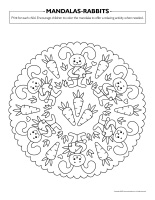
Mandalas-Rabbits
(Open mandalas-Rabbits) Print for each child. Encourage children to color the mandalas to offer a relaxing activity when needed.
Rabbit faces
Use makeup to paint children’s faces to make them look like rabbits.
Our group rabbit
Draw a giant rabbit outline on a large piece of paper and invite children to work as a group to decorate it.
Chick or rabbit
Stand at one end of your daycare. Have children stand with their back to the wall, at the opposite end. Show them a rabbit picture. They must hop towards you. When you show them the chick, they must get down on their hands and legs and pretend to peck the ground. Alternate between both pictures until children reach you.
MUSICAL ACTIVITIES
Musical rabbit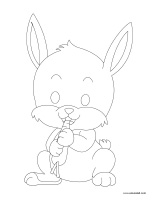
Sit in a circle with your group. To the sound of music, have children pass a rabbit figurine around the circle. When the music stops, the child holding the rabbit is eliminated. The music starts again and the game continues.
The rabbit’s burrow
Set hula hoops on the floor. Children hop around them like rabbits, to the sound of music. When the music stops, each child must hop in a burrow (hula hoop) as quickly as possible. Remove one hula hoop at the end of each round. If a child does not find a burrow, he is eliminated.
Rabbit gym
Rabbits must train for the big Easter egg hunt. Lead an aerobics session for your little rabbits. Be creative!
CULINARY ACTIVITIES
Sprout rabbits
For each child, you will need a bunny-shaped cookie cutter. They must set their cookie cutter in an aluminum pie plate and fill it with cotton balls, pressing down on them. Provide watercress seeds (or other type of seeds) and have children sprinkle them on their cotton balls. Set the rabbits next to a sunny window. Daily, encourage children to water their seeds using a spray bottle. Very quickly, you will see the seeds sprout. When they have grown enough, children will enjoy cutting them and adding them to sandwiches and salads.
Carrots from appetizer to dessert
Like little rabbits, encourage children to eat carrots. To begin, serve carrot soup. Accompany your main course with baby carrots. For dessert, serve carrot cake or carrot muffins. Have fun pretending you are are rabbits as you eat!
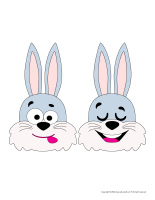
ARTS & CRAFTS
My miniature rabbit
(Open model-Bunny) Print, cut out, and color the models. Transform empty toilet paper rolls to make them look like rabbits by gluing the various pieces on them. Hang the miniature rabbits from the ceiling.
Rabbit stamps
Use pipe cleaners to create rabbit-shaped stamps that children will love to manipulate. For each stamp, bend a pipe cleaner in half and form a circle with the “bent” section. Twist both parts of the pipe cleaner just over the circle to close it off. Next, shape a rabbit ear with each unbent extremity and twist them at the base to complete your bunny heads. Show children how they can press the rabbits in poster paint and then on paper to create prints. Let dry. Once the paint is dry, children can draw eyes, a nose, a mouth, and whiskers on each rabbit.
Rabbit figurines
Have each child pick a plastic Easter egg as well as a pipe cleaner of the corresponding color. Help children cut their pipe cleaner to obtain one long piece (2/3 of length) and a short piece (1/3 of length). Next, have them cut the longer piece in half and use the 2 pieces to create rabbit ears that they can glue on the top of their Easter egg. Have them do the same thing with the shorter piece to create 2 rabbit feet that they can glue on the front of their egg, at the bottom. To help their rabbit stand up, they can glue a large pompom behind it, close to the bottom to represent a bunny tail. Using a permanent marker, they can draw a rabbit face. Children will love playing with these figurines throughout the theme.
Adorable little feet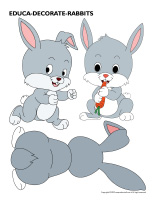
Paint the bottoms of children’s feet with pink washable paint and encourage them to make impressions on heavy white paper. Let dry. Once the paint is dry, help children cut their footprints out, keeping a white contour around each one. Give each child a white Fun Foam circle and have them glue their footprints near the top of their circle to represent bunny ears. Next, have them cut a small nose our of pink felt and glue it in the center of their circle. They can draw bunny eyes and whiskers using a marker.
Potato masher rabbits
For this project, invite children to pick a piece of colored construction paper and place it vertically in front of them. Give each child a plastic knife and have them press the “blade” in a platter containing white poster paint and make 2 vertical impressions at the top of their paper, leaving approximately 5 cm between the 2. They will represent rabbit ears. Next, have children press a potato masher in the platter and make 2 impressions, one on top of the other under the ears to represent a bunny head and body. Let dry. Once the paint is dry, children add 2 wiggly eyes, a cotton ball (on the side of the body), and a bunny nose and whiskers cut out of Fun Foam.
Oh-so-soft bunnies
For each child, you will need a gray or white adult sock. Fill a measuring cup with rice and help children pour the rice in the bottom of their sock. Above the filled portion of each child’s sock, knot a piece of yarn that is the same color as the sock to create a bunny body. Next, children pour a smaller quantity of rice inside their sock and tie another piece of yarn above the rice to create a bunny head. Let children cut the top of their sock vertically to create 2 bunny ears. With a permanent marker, they can draw an “X” to represent a bunny nose and 2 dots for bunny eyes. Provide different colors of ribbon and help children tie a bow around their bunny’s neck. Set these oh-so-soft bunnies on a shelf to decorate your daycare.
My rabbit hat
(Open educa-decorate-Rabbits) Print and cut out. Glue the items around a paper headband or a hat.
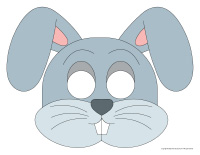
Masks-Rabbits
(Open masks-Rabbits) Print for each child. Provide crayons, glue, and glitter that children can use to decorate their mask.
Decorated carrots
Print and cut out large carrot shapes. Let children draw on them and decorate them using a variety of arts & crafts materials: feathers, glitter, fabric pieces, etc. Display the carrots in the area where children eat meals.
Puppets-Rabbits
(Open puppets-Rabbits) Print the various models on cardboard. Ask children to cut them out and decorate them with arts & crafts materials. Glue a Popsicle stick behind each one to complete the puppets.
Models-Rabbits
(Open models-Rabbits) Print the various models and use them for your activities and projects throughout the theme.
Modeling dough rabbits
Prepare white homemade modeling dough and have children use it to create rabbits. You can add rice to your dough to provide an interesting texture. Provide tiny pastel wiggly eyes that children can press in the dough.
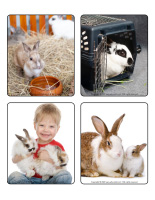
My rabbit book
Cut several rabbit pictures out of magazines, old books, etc. Glue them on pieces of paper measuring 10 cm x 13 cm. Arrange the pictures in Ziploc bags, adding 2 back-to-back pictures to each bag. Staple them all together at the closed end so that you can open the bags if you need to.
COLORING PAGES
(Open coloring pages theme-Rabbits) Print for each child.
Have fun!
The educatall team
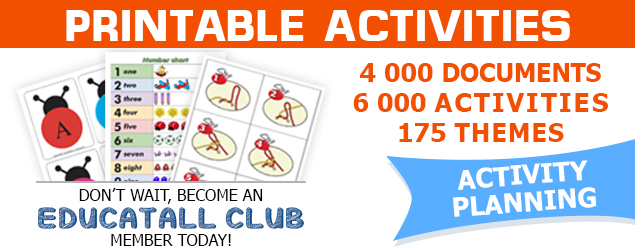
 Home
Home Theme activities
Theme activities
 Babies and toddlers
Babies and toddlers
 Arts and crafts
Arts and crafts
 Science
Science
 Creative recipes
Creative recipes
 Tips and tricks
Tips and tricks
 Special needs
Special needs
 Extra activities
Extra activities
 Educ-TV
Educ-TV
 Newsletter
Newsletter  Online store
Online store Educatall club
Educatall club


